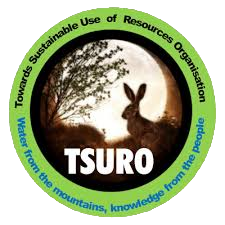Nature Positive Food Systems

Project Manager
Mrs Roseline Mukonoweshuro
TOWARDS SUSTAINABLE USE OF RESOURCES ORGANISATION TRUST’S NATURE POSITIVE FOOD SYSTEMS (NATURE +) PROJECT SUMMARY:
- Background:
Towards Sustainable Use of Resources Organisation (TSURO), Trust is implementing a Nature Plus (+) project in Zimbabwe, Manicaland Province, Chimanimani District, Bumba community. The Nature + Project seeks to upscale nature-positive food systems for enhanced climate change adaptation. The 3-year project is still in the inception phase having started in October 2023 and ending in December 2025. The project budget is US$ 1,8 million (funded by Global Affairs Canada (GAC) & and Canadian Foods Grain Bank (CFGB). The project’s operational area was chosen on the basis that it is situated within a buffer zone, surrounding the Bvumbura Core Zone, one out of five core zones of the Chimanimani Biosphere Reserve. The project is targeting a total of 875 households with an average household size of 5.6 people, amounting to 4,902 inhabitants.
What the project seeks to do? The project seeks to contribute towards the improvement of livelihoods, governance system, gender, and the community’s ability to develop Nature Based Solutions (NBS). This is being accomplished through activities that ensure that all marginalized groups are food and nutrition secure, acquire business skills and access to markets, and community cohesion encourages women to take up leadership positions and decision-making roles through the promotion of gender-sensitive programming. The project is hinged on these key pillars which are; enhanced adoption of gender-responsive nature-based solutions, enhanced climate resilient livelihoods based on the sustainable use of biodiversity, and increased decision-making and leadership of women and other vulnerable people in the community, strengthening landscape governance systems for improved biodiversity and climate change adaptation. The following activities are earmarked to promote NBS;
1.1 Conservation Agriculture: This component of the NBS covers the promotion of key elements of conservation agriculture which are minimum soil disturbance, permanent soil cover, and crop diversification. Key aspects of minimum soil disturbance include farmers’ training on how to use and apply locally adapted practices which include the use of hand hoes, and tine rippers so that mechanical soil disturbance is reduced to an absolute minimum or avoided at all. Key issues to promote permanent soil organic cover with crop residues and/or cover crops such as mulching and Green Manure and Cover Crops (GMCC) will be promoted. Crop or plant diversification will be trained, promoted, and demonstrated through community-based seed systems and agroforestry. A range of soil health and fertility improvement techniques which include composting, fermented bio-fertilizers, Holistic Land and Livestock Management (HLLM) field impactions, no burning of stover principle, mulching, agroforestry, reduced use of pesticides and other chemicals to protect the microbes and soil organism, crop rotations, composting and pit composting, liming and or wood ash, especially in the garden, use of animal manure from cattle, goats and chicken will be used. Overall, all crop management aspects including integrated pest and disease management will be covered. Also, diversification options such as mushroom production, aquaculture, and apiculture will be promoted as well as diversified rearing of small livestock
1.2 Holistic Land and Livestock Management: the approach seeks to sustain people’s livelihoods through collective herding and controlled timed grazing. HLLM is meant to rehabilitate and improve land and water resources upon which the ecosystem, animals, and rural communities depend. The project implementation undergoes several participatory community processes which build a firm foundation for stockowners to bring their livestock together, and form one big herd managed by highly trained herders. The process promotes the natural cultivation of bare lands through livestock hooves breaking the soil capping, reducing water run-off, improving seepage of rainwater into the ground, and recharging the water table thereby restoring the land, wells, streams, rivers, and health ecosystem. The concept helps in climate change mitigation in several ways such as avoidance of overgrazing and over resting there by keeping perennial grasses healthy which minimizes the need to burn then exposing the soil to the drying effects of the sun and carbon emission.
1.3 Landline design and civil works:These ensure maintaining healthy land, biodiversity, and re-charged water tables. A diversity of techniques shall be used to design the landscape, as per the landscape needs and demands to achieve the best results under each piece of land and to make the land more resilient or less prone to future shocks and hazards through the establishment of diverse suitable land protection measures. The public extension workers and lead farmer landline design champions shall be fully equipped for the following techniques and skills; eco-visioning, land use planning, home designing, use of the appropriate civil works technology (e.g. the A-frame), pegging, establishment, and maintenance of land protection measures (mitre drains, swales, contour ridges, storm drains, gabions, stone terracing, biological terracing, etc), Rainwater harvesting and catch/earth dams development.
2. Livelihoods To achieve enhanced climate-resilient livelihoods especially for vulnerable and marginalized groups climate resilient livelihoods will be promoted and supported. Aquaculture, beekeeping, mushroom production, small livestock production, and piped water schemes are the livelihoods that will be introduced. All these livelihood activities will be tailored in such a way as to reduce barriers to participation among marginalized groups. These livelihood options are also very appropriate for vulnerable groups as they will bring benefits like food security, improved income, improved nutrition, and many more.
For all this to be successful TSURO works together in collaboration with other partners like CELUCT, and local Universities that as the University of Zimbabwe, Bindura University, and Fambidzanai School of Agroecology.

